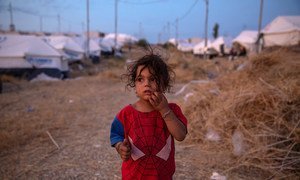Tuesday’s Daily Brief: Nearly 180,000 displaced in Syria's northeast, millions of young lives hinge on funding, WHO urges lead paint ban
A recap of Tuesday’s main stories: Syria's northeast sees 180,000 displaced two weeks into fighting; funding shortfalls puts millions of young lives on the line; assistance breakthrough for Yemeni's; UN health agency urges ban on lead paint; Libyan child deaths in Tripoli attack.
Nearly 180,000 displaced by northeast Syria fighting as needs multiply

After nearly two weeks of fighting in northeast Syria, the UN’s humanitarian wing has estimated that around 180,000 have been forced to leave their homes or shelters, including 80,000 children, all in desperate need of humanitarian assistance.
The UN Office for the Coordination of Humanitarian Affairs (OCHA) reported on Tuesday that despite a shaky five-day ceasefire, airstrikes and a ground offensive launched by Turkey on 9 October, targeting Kurdish held areas across the border, has had a “significant humanitarian impact.”
According to news reports on Tuesday, Turkey’s President Recep Tayyip Erdogan said his forces would resume their offensive unless Kurdish fighters fully withdraw from the border area by the day’s end.
Here’s our full story.
Millions of young lives at risk due to humanitarian funding shortfall

“Substantial” shortfalls in humanitarian funding are placing the lives of millions of children in areas affected by conflict and disaster at risk, the UN Children’s Fund (UNICEF) warned on Tuesday.
With 2019 almost over, the agency reported that it has still only received just over half of the $4 billion it needs this year, to provide life-saving health, education, nutrition and protection programmes for 41 million children in nearly 60 countries worldwide.
UNICEF said the consequences will be “dire” if the shortfalls persist through the end of the year.
Our full story here.
UN food agency reaches besieged Yemenis

Whilst most residents in Durayhimi City, Yemen, have fled the fierce fighting between pro-Government and rebel Houthi forces, some 200 civilians remain trapped.
On Tuesday, the World Food Programme (WFP) announced that they have managed to reach these highly vulnerable people, and provide much-needed humanitarian assistance.
In a statement, WFP said that the war is taking a heavy toll on those still living in the city; food is scarce, shops are bare, and health facilities are non-existent.
This is only the second time in over a year that WFP has been able to reach the town, which lies around 20 kilometres south of the crucial port city of Hodeidah where a fragile UN-brokered truce has been observed for some months.
UN health agency launches week of action to ban lead paint

Although exposure to lead remains a key global health concern, particularly as it impacts childhood development, only 73 countries have legally binding controls for lead paint, the World Health Organization (WHO) has reported.
Lead exposure killed more than one million people in 2017, according to data cited by WHO, which is why the UN agency and partners are this week urging countries to take action to ban lead paint.
Lead is stored in the teeth and bones and accumulates over time, affecting multiple body systems. It is distributed to the brain, liver, kidney and bones. As young children’s nervous systems are still developing, they can absorb up to five times more lead than adults.
Here’s our coverage.
Children killed and injured in ongoing Libya fighting

Children continue to suffer from violent conflict in the Libyan capital, Tripoli, said the UN Children’s Fund, UNICEF, on Tuesday.
Ted Chaiban, UNICEF’s Regional Director for the Middle East and North Africa, said, in a statement that “violence has taken a heavy toll on children in Tripoli” and the surrounding area, over the past two weeks.
That toll reportedly includes the death of three children and two women, killed while driving on a highway, 16 kilometres from the capital; a 13-year-old child killed in his house; and three sisters and their mother killed, while a fourth sister was badly injured, when their house was hit by an airstrike.
The latter incident was also condemned by the UN Mission in Libya, UNSMIL, which expressed its shock at the attack, which it described as “particularly egregious”.
Listen to or download our audio News in Brief for 22 October on SoundCloud:

